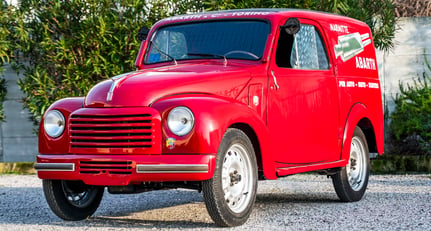1952 Fiat Topolino
Giardinetta Belvedere “Marmitte Abarth”-
Baujahr1952
-
Kilometerstand79 700 km / 49 524 mi
-
AutomobiltypSonstige
-
LenkungLenkung rechts
-
ZustandRestauriert
-
InnenfarbeBraun
-
InnenausstattungLeather
-
Anzahl der Türen2
-
Zahl der Sitze2
-
Standort

-
AußenfarbeRot
-
GetriebeManuell
-
Leistung12 kW / 17 PS / 17 BHP
-
Antrieb2wd
-
KraftstoffPetrol
Beschreibung
The car we offer has been completely restored by the owner, a well-known collector and former racer. It is presented today in excellent condition, both in terms of bodywork and mechanics. The car is equipped with an Italmeccanica volumetric compressor, special Fergat wheels, and, of course, Abarth exhaust. Ready to use, available for viewing and testing.
The Fiat 500 was born between the two world wars with the aim of offering an economical car to initiate motorization in the country. Its compact size and vague resemblance to Walt Disney's character led to its nickname "Topolino," which, while remaining a nickname, identified the three series produced from 1936 to the post-war period in 1955.
In the early thirties, Fiat needed to produce a compact and economical car to facilitate the spread of automobiles in Italy. Initially, the idea of the then technical director, engineer Antonio Fessia - who would later move to Lancia and become the father of the Lancia Flavia and more - was to produce a "tutt'avanti" car, with front engine and front-wheel drive. This was an unusual architecture for the time when the engine was at the front, but the drive was always at the rear. Unfortunately, Fessia had to curb the innovative push due to an issue during the testing of the first prototype. Thus, in 1934, the project was handed over by the same engineer to the young Dante Giacosa, who had previously worked on aviation engines.
Cost containment continued to guide the design choices of Giacosa's new team. The layout became traditional, with a front engine and rear-wheel drive, but something unusual remained. The four-cylinder engine was placed in front of the front axle but also in front of the radiator.
With a displacement of 569 cc, which gave it the official name "Fiat 500," the engine had side valves, making it particularly low. The surrounding components were made as simple and economical as possible: the radiator, placed behind the engine in a raised position, did not require a water circulation pump because it used the principle of a thermosiphon, lifting the hotter water upwards. The power produced was 13 HP, propelling the 740 kg at full load up to 85 km/h.
The low engine with the radiator behind allowed for an aerodynamic and tapered hood, with external headlights that, in the imagination of those who saw them from inside the car, resembled the ears of the Disney character Mickey Mouse: hence the nickname that quickly became popular and identifying for the small car.
In June 1936, Fiat 500 was officially presented to the public as the "new small great car of savings and work," as emphatically defined by the Istituto Luce film while advancing on the terrace of the Circolo della Stampa, showcasing its compactness.
In 1948, the second series was born, evolving into the four-seater Giardiniera Belvedere version, embracing new styles with the third series in 1949, in production until 1955 when it passed the baton first to the 600 and then alongside the Nuova 500.
After the unfortunate events that saw Turin heavily bombed during World War II, Topolino production exceeded 120,000 units. It was time for the launch of the Fiat 500 B, which took place at the Geneva Motor Show in 1948. The body remained almost unchanged, with changes to the dashboard, steering wheel, and hood latches, while most of the innovations were hidden: the displacement remained the same, but the new cylinder head containing the valves and the new carburetor with a fuel pump allowed for an almost 30% increase in power, bringing the maximum speed to 95 km/h. Also new were the braking system, hydraulic shock absorbers, and the electrical system. Alongside the sedan and convertible versions, the "500 Giardiniera Belvedere" was born, a family version capable of accommodating four people, with a body inspired by American station wagons with wood paneling. The rear door allows convenient access to the cargo space, which can increase its capacity by folding the back seat. Production of the Fiat 500 B ended after about a year and approximately 21,000 units assembled. In March 1949, the third series, the Fiat 500 C, made its debut at the Geneva Motor Show, adapted to new stylistic trends with headlights recessed into the fenders, a horizontally developed grille, and the engine hood becoming a single piece with internal opening. The spare wheel is now housed in a new dedicated compartment, accessible from the outside through a lockable door. The engine evolved again with the adoption of an aluminum cylinder head, but the performance remained almost unchanged, despite the overall weight increase to 800 kg. Equipment also improved, with the introduction of the windshield defrosting system combining with the cabin heating system. After over 376,000 units, production of the Fiat 500 C in its different versions ended in 1955. The Topolino, especially the Giardiniera Belvedere, became one of the protagonists of the post-war period: a perfect family car for Sunday outings transformed into a versatile van for all kinds of work, from artisans to bakers.





























